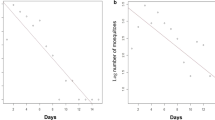Summary
A mark-release-recapture experiment to estimate population survivorship and absolute size was performed with wild-caughtAn. subpictus adults at the village of Khano-Harni, Lahore District, Punjab Province, Pakistan during September 1978, the end of the monsoon rainy season, when temporal population abundance was maximized. Daily survival rate estimated from the recapture sequence of marked adults was low, males=0.192 and females=0.343. Survivorship for females estimated by several vertical age-grading procedures ranged from 0.347 to 0.628. Both stage- and age-specific life tables were calculated from vertical age-grading data determined by the dilatation method. Female and male population size was estimated byBailey’s modification of theLincoln Index and was found to average 4478.4 and 6106.8, respectively. The bionomics, survivorship and population size ofAn. subpictus in the Lahore are indicated that this species was probably not important in the transmission of human malaria.
Similar content being viewed by others
References
Afridi, M. K., J. Singh andH. Singh (1939) Food preferences ofAnopheles mosquitoes in the Delhi urban area.J. Mal. Inst. India 2: 219–228.
Ansari, M. A. R. andA. S. Nasir (1955) A preliminary note of anophelism of Lahore suburbs.Pak. J. Hlth. 4: 212–223.
Bailey, N. T. (1952) Improvements in the interpretation of recapture data.J. Anim. Ecol. 21: 120–127.
Bhatia, M. L. andK. S. Krishnan (1961)A. culicifacies Giles, 1901. In:Vectors of malaria in India. National Society of India for malaria and other Mosquito-Borne Diseases. Delhi, India. pgs. 147–186.
Bruce-Chwatt, L. J., C. Garrett-Jones andB. Weitz (1966) Ten years’ study (1955–1964) of host selection by Anopheline mosquitoes.Bull. Wld. Hlth. Org. 35: 405–439.
Davidson, G. (1954) Estimation of the survival-rate of anopheline mosquitoes in nature.Nature (London),174: 792–793.
Davis, E. W. andD. J. Gould (1973) A portable suction apparatus for collecting adult mosquitoes.Mosq. News 33: 246–247.
Deevey, E. S. (1947) Life tables for natural populations of animals.Quart. Rev. Biol. 22: 283–315.
Detinova, T. S. (1962)Age-grouping methods in Diptera of medical importance. World Health Orgnaization, Geneva. 210 pgs.
Gillies, M. T. (1961) Studies on the dispersion and survival ofAnopheles gambiae Giles in East Africa by means of marking and release experiments.Bull. Ent. Res. 53: 99–127.
Gundelfinger, B. R., C. H. Wheeling, J. C. Lien, S. Atmosoedjono andC. H. Simanjuntak (1975) Observations of malaria in Indonesian Timor.Amer. J. Trop. Med. Hyg. 24: 393–396.
Itô, Y. (1973) A method to estimate minimum population density with a single recapture census.Res. Popul. Ecol. 14: 159–169.
Knight, K. L. andA. Stone (1977) A catalog of the mosquitoes of the world (Diptera: Culicidae). 2nd Ed.The Thomas Say Foundation 6: 1–611.
Krafsur, E. S. (1977) The bionomics and relative abundance ofAnopheles species with respect to the transmission ofPlasmodium in man in Western Ethiopia.J. Med. Entomol. 14: 180–194.
Krishnan, K. S. (1961)A. stephensi Liston, 1901. In:Vectors of malaria in India (2nd Edition). National Society of India for Malaria and other Mosquito-Borne Diseases, Delhi, India. pgs. 39–58.
Ludlam, K. W. (1971) Feeding behavior of six common anophelines of West Pakistan. Ph. D. Dissertation, University of Maryland, College Park, 67 pgs.
Manly, B. F. J. andM. J. Parr (1968) A new method of estimating population size, survivorship and birth rate from capture-recapture data.Trans. Soc. British Entomol. 18: 81–89.
Mehta, D. R. (1934) Studies on the longevity of some Indian anophelines, Part I. Survival ofAnopheles subpictus Grassi under controlled conditions of temperature and humidity.Rec. Mal. Surv. India 4: 261–272.
Mer, G. G. (1936) Experimental study on the development of the ovary inAnopheles elutus,Edw. (Diptera: Culicidae).Bull. Ent. Res. 27: 351–359.
Nelson, R. L., M. M. Milby, W. C. Reeves andP. E. M. Fine (1978) Estimates of survival, population size and emergence ofCulex tarsalis at an isolated site.Ann. Ent. Soc. Amer. 71: 801–808.
Reisen, W. K. (1978) A quantitative mosquito survey of 7 villages in Punjab Province, Pakistan, with notes on bionomics, sampling methodology and the effects of insecticides.Southeast Asian J. Trop. Med. Publ. Hlth. 9: 587–601.
Reisen, W. K., andM. Aslamkhan (1978) Biting rhythms of some Pakistan mosquitoes.Bull. Entomol. Res. 68: 313–330.
Reisen, W. K., andP. F. L. Boreham (1976) Host feeding patterns of some Punjab mosquitoes (Diptera: Culicidae): a short term survey.Biologia 22: 299–304.
Reisen, W. K., andBoreham, P. F. L. (1979) Host selection patterns of some Pakistan mosquitoes.Amer. J. Trop. Med. Hyg. 28: 408–421.
Reisen, W. K., M. Aslamkhan, M. Suleman andZ. A. Naqvi (1976a) Observations on the diel activity patterns of some Punjab mosquitoes (Diptera: Culicidae).Biologia 22: 67–77.
Reisen, W. K., M. Aslamkhan andZ. A. Naqvi (1976b) Observations on the resting habits and diel changes in the ovarian condition of some Punjab mosquitoes (Diptera: Culicidae).Biologia 22: 79–88.
Reisen, W. K., F. Mahmood andT. Parveen (1979)Anopheles culicifacies Giles: a mark-release-recapture experiment with cohorts of known age in Pakistan with inplications for malaria epidemiolgy and genetical control.Trans. Roy. Soc. Med. Hyg. (in press)
Roy, D. N. (1943) The role ofAnopheles subpictus Grassi as a carrier of malaria.J. Mal. Inst. India 5: 117–121.
Russell, P. F., T. R. Rao andV. P. Jacob (1939)Anopheles subpictus Grassi, 1899, andAnopheles vagus Dönitz, 1902, found naturally infected with malaria plasmodia in South Eastern India.J. Mal. Inst. India 2: 95–99.
Russell, P. F., L. S. West, R. D. Manwell andG. Macdonald (1963)Practical malariology. Oxford University Press, London, 750 pgs.
Service, M. W. (1977) Ecological and biological studies onAedes cantas (Meig.) (Diptera: Culicidae) in southern England.J. Appl. Ecol. 14: 159–196.
Sokal, R. R. andRohlf, F. J. (1969)Biometry.W. H. Freeman and Co., San Francisco, Ca. 776 pgs.
Wattal, B. L. (1961) Dissection records of wild caught Anopheline mosquitoes other than the reputed vectors of malaria. In:Vectors of malaria in India (2nd edition), National Society of India for Malaria and other Mosquito-Borne Diseases. Delhi, India. pgs. 187–231.
Yasuno, M., P. K. Rajagopalan, S. Russell andG. C. LaBrecque (1972). Dispersal ofCulex fatigans in Delhi villages. WHO/VBC/72.352. 13 pgs (working document).
Author information
Authors and Affiliations
Rights and permissions
About this article
Cite this article
Reisen, W.K., Mahmood, F. & Parveen, T. Anopheles subpictus Grassi: Observations on survivorship and population size using mark-release-recapture and dissection methods. Res Popul Ecol 21, 12–29 (1979). https://doi.org/10.1007/BF02512636
Issue Date:
DOI: https://doi.org/10.1007/BF02512636




